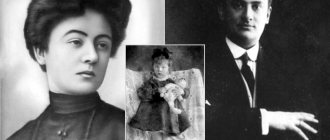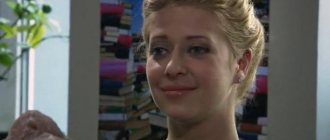Childhood and youth
Olga Platonova was born on April 23, 1972 in Moscow. In an interview, the TV presenter said that for several generations in a row her family lived on Malaya Nikitskaya Street. Opposite the house, in the Church of the Ascension of the Lord, the capital's first beauty once got married - in those distant times, one of Olga's great-great-great-grandfathers served as a priest at the temple.
It is possible that Platonova’s interest in design and sense of beauty were formed under the influence of the environment that surrounded her in childhood. The apartment in the center of Moscow where she lived had a spirit of antiquity; The first thing the girl saw when she opened her eyes in the morning was the stucco decoration in the shape of angels. The TV presenter admits that when working on the interior of her own home, she was guided by the memories of her parents’ “nest” - she wanted to be among things similar to those that surrounded her in childhood.
Olga received her higher education at the Moscow State Pedagogical Institute of Foreign Languages. Maurice Thorez (now Moscow State Linguistic University). In her diploma, her specialty is designated as “English teacher,” and the TV presenter also speaks French and Georgian. Platonova defended her PhD thesis on the topic “Bilingualism in the USSR”, completed a number of courses in interior design, floristry, fundamentals of European architecture, etc.
Career
2010 was a turning point in the life of Olga Platonova - on April 25, the TV magazine “Everything in the Garden” premiered on the TVC channel. The show was positioned as a “television gardening guide” with the participation of experts and famous people.
Once a week, Platonova paid visits to movie stars, pop stars, writers and composers - they willingly showed the presenter and viewers their plots and gave advice to beginners and experienced gardeners. For example, a participant in the first edition spoke about his bonsai-style winter garden.
Olga’s television career did not end there; on the contrary, it was just the beginning. In 2011 and 2012, her author’s program “Garden Stories” was broadcast on the “Trust” channel. Original design solutions, expert advice, master classes - this is how the creator herself described the program.
Olga Platonova in the program “Hacienda”
Platonova dedicated the years 2012 and 2013 to a new project - the “Lucky Mood” section in the morning program “Mood” on the TVC channel.
In 2013, the gardener and designer appeared in the First Channel program “Good Morning” as the host of the “Useful Tips” section. Each issue was dedicated to a particular topic, and it was not only about gardening life hacks (like “how to make fertilizer from cardboard”), but also about cooking, phytodesign and design in general.
Project by Olga Platonova “Winter Garden”
In 2013 and 2014, the TV presenter visited the set of another Channel One project, “Time to Lunch,” where, together with the show’s hosts and Lyudmila Poryvay, she shared recipes and culinary secrets with the audience. Also during this period, Platonova took part as a guest expert in the filming of the program “Good Health!” s and .
From 2006 to 2020, the television program “Fazenda” was broadcast on Channel One. Initially, its host was, later he was replaced by Roman Budnikov. The advice given to viewers by the show's experts covered all areas of country life.
Olga Platonova joined the “Fazenda” team as a specialist in the field of gardening and vegetable gardening; she shared her knowledge with the audience (among the topics of the episodes, for example, “How to grow geraniums at home”) until the end of the program.
In 2020, a new television project called “Country Fairies” appeared in Olga’s creative biography. The trio of presenters, which, in addition to Platonova, included an expert in the field of growing crops and showman Sergei Asharin, transformed the territory of VDNKh in real time.
Olga Platonova tells how to grow dahlias
The topics of the issues are “Digging up dahlias”, “Processing garden strawberries in spring”, “Forming a hedge from spruce”, etc. “Country Fairies” are still shown on the “Beaver” TV channel.
A kind of spin-off of “Country Fairies” was the program “Telecafe”, in which, under the guidance of the same presenters, viewers learned the secrets of culinary skills.
Since July 3, on the daytime air there has been a stale new product for those for whom it’s time to think about the soul and garden beds - the “Country Fairies” program has moved from the “Beaver” satellite channel to the first button. Apparently, the summer season didn’t get off to a great start and Channel One went all in, launching heavy artillery on the day off. Will the gardening show be able to win the love of the audience or will it remain unclaimed?
"Country Fairies" on First
There are already three presenters in the “Country Fairies” program! Two fairies and one fairy. At VDNH (in the capital of Russia), the trio was allocated 6 acres. Their task is to improve a piece of land: lay out beds on it, plant bushes and improve existing trees. In general, in real time during the summer season, the hosts tell you how to properly care for plants, how to plant, and what you should pay attention to. The personalities of the presenters are interesting in themselves. I suggest washing the bones a little.
“Country Fairies” on First | Oktyabrina Ganichkina
The second eccentric madam is TV presenter Olga Platonova. Sometimes I caught her on the air of Channel One - she was cutting salads on Good Morning and did not inspire confidence. By education, Olga Platonova is an English teacher, but in life there are many things: designer, architect, psychologist. But her main topic is landscape design, so in the “Country Fairies” project she is responsible for beauty - trees, shrubs, flowers. He knows many secrets and happily shares them with the audience. Olga Platonova’s age is also shrouded in mystery. Unlike Ganichkina, Platonova not only takes care of her garden, but also devotes time to her own beauty. The skin on the face is stretched like a drum, plastic is visible to the naked eye. Pigtails clearly don’t suit her and create the image of a country madwoman, but loose hair tied back in a bun, on the contrary, makes the TV presenter look younger and more interesting. At first I liked it after watching several episodes of “Country Fairies,” and then I googled the information and... I got hooked. The aunt who professes positivism turned out to be a scandalous and greedy citizen. I'm shocked!
“Country Fairies” on First | Olga Platonova
Sergey Asharin. He stands between the two fires of Oktyabrina and Olga and runs between them, helping one or the other. Sergei embodies the image of an incompetent city dweller who is at ease with land and seedlings. The aunts share their experiences with him, and he sets a positive mood with jokes and grimaces. Before “Dachnaya Fairies,” Asharin hung out on shabby channels and now his finest hour has come. The bald fairy has been repeatedly spotted by Google at social events, accompanied by other famous unmarried men.
So, let's move on to the main thing: whether you liked it or not, to watch it or not to watch it. You know, if you don’t go into the personal life and career of the hosts of the “Country Fairies” show, then you can and even should watch it. As an experienced gardener, I took some of Oktyabrina’s advice into bookmarks and will certainly use them. I like Ganichkina the least as a presenter. An itchy granny belongs on the Usadba channel, not on Channel One. Well, or let them write her a normal text. Olga Platonova is tongue-tied - she speaks competently, beautifully and to the point. If you unsee the scandalous information about her from the Internet, then she belongs on the First. By the way, as part of the program, Ganichkina and Platonova gossip behind each other’s backs, criticize and identify annoying mistakes in their rival. It seems like it’s funny to watch this, but on the other hand, who to believe? In enchanting disputes, Platonov always wins.
"Country Fairies" on First
Episodes of “Country Fairies” last just under half an hour and time flies by. The program contains a lot of useful information, it is presented simply and clearly. This is a definite plus.
“Country Fairies” on First | Olga Platonova, Oktyabrina Ganichkina, Sergei Asharin
Overall, I liked “Country Fairies.” If it weren’t for the fake Potemkin garden with beds and the scandalous information about the presenters, I would have given the rating higher. I give three stars and recommend watching!
“Country Fairies” on First | Sergey Asharin
The “Country Fairies” program is broadcast daily 2 times a day on the “Beaver” TV channel and on Sundays at 12.15 Moscow time on Channel One. All episodes can be watched online in high quality after the premiere on the official website of the project
.
Thank you for your positive ratings and comments!
Do you want to keep up to date with all the latest movies and TV shows and read the most objective reviews? Then I recommend doing the following:
1. If you are registered on Irecommend, add my profile to your review subscriptions
2. Don't want to subscribe or are not registered, but want to read? Add my profile to your browser bookmarks (Ctrl + D)
3. My reviews are always easy to find through the Yandex and Google search engines - just type in the search bar: “Andy Goldred Reviews” and press Enter
Sincerely, Andy Goldred
Several generations of my family lived on Malaya Nikitskaya Street,” says Olga. — In the Church of the Ascension of the Lord, which is opposite the house, one of my great-great-grandfathers served as a priest when Alexander Pushkin got married there. But contrary to fashion, I moved from the center of the capital to the countryside. Traffic jams under the windows, thousands of cars... Moreover, I have four children in my family. I wanted space and air. I bought a dacha in Mamontovka. The plot of 28 acres was improved so quickly that it became boring. I asked the realtors to find something on a larger scale. They were dumbfounded and said that then we should consider options with old pioneer camps and sanatoriums. I agreed. An abandoned rest house of the Pravda publishing house was found, where the entire Soviet elite rested. Hectare of land. By that time, I had successfully sold my dacha in Mamontovka, so I had the money to buy this plot. But there were difficulties with the design. The intended purpose of the land according to the documents is a holiday home, and not individual construction. This means that you need to pay huge taxes. It took two years to change the status of the land. And the appearance of the former boarding house was depressing: a peeling concrete fence, dilapidated buildings, waist-deep weeds. The building, which was once a dining room, was demolished and two gazebos were built on its foundation. The central dormitory building with a corridor system was lined with stone, and two semi-rotundas were attached to it. We live in it. The sports building was converted into a guest house, studio, winter garden and water park with a home cinema. Since I got the boarding house furnished, I received many sofas and 22 Temp TVs, as well as a countless number of carpets. I gave the best ones to friends, and laid the rest under the apple trees to insulate the roots for the winter.
“My husband is hostile to any of my ideas. But I’m already used to it and don’t argue.”
“It is in this room that my stories for the Hacienda program are filmed.
An artificial pond with waterfalls and fish, paths, gazebos, flower beds, and greenhouses appeared on the site. She developed the interior and landscape designs herself. I have 15 certificates of completion of various courses. This house was decorated in the style of Russian classicism. Many people, entering here for the first time, believe that a huge amount of money was spent on its furnishings. This is wrong. I developed the project myself. I bought some of the furniture and decorative elements at flea markets, and then finished it myself with the craftsmen. I bought the silk with which some of the walls were upholstered in Pavlovsky Posad for 100 rubles per meter. I sewed the fringed curtains and bedspreads myself. Upholstered a cheap chipboard kitchen in bronze. The main thing here is to show your imagination.
About the transfer:
Fairies are known to have magic and wizardry. And “Country Fairies” Olga Platonova and Oktyabrina Ganichkina have a huge store of knowledge, which, and most importantly, when is the best time to grow and plant on a country plot. Oktyabrina and Olga will not only tell you, but also show you how to grow a real miracle from a small seed. We are sure that the “Country Fairies” program is suitable for both beginners and experienced summer residents. True, fairies sometimes argue on this or that issue, but in a dispute, as we know, the truth is born. And the charming and ironic co-host Sergei Asharin will help Oktyabrina Ganichkina and Olga Platonova. He will not only, together with the viewers of the project, gain gardening experience from the main characters, but will also be responsible for the cheerful mood on the set. The location for filming the weekly program was the territory of VDNKh in Moscow: it is there that the “Country Fairies” will create an exemplary plot almost in real time.
Genre:
Programs
Year of release:
2016
Released:
Russia, Channel One
Presenters:
Oktyabrina Ganichkina, Olga Platonova, Sergey Asharin
A program on Channel One in which experts share tips with gardeners and gardeners.
In the program " Country Fairies"
» presenters
Olga Platonova
and
Oktyabrina Ganichkina
will tell and show what, how and, most importantly, when is the best time to grow and plant on a country plot.
About the program Country Fairies
The program is hosted by two professional fairy gardeners and their young assistant, who is just getting acquainted with the intricacies of caring for a vegetable garden.
Oktyabrina Ganichkina
- specialist in growing crops, author of dozens of reference books for gardeners ("All about the garden and vegetable garden in questions and answers", "Gardener's Handbook", "Favorite Flowers", etc.) - well known not only to viewers of the First channel.
Oktyabrina hosts several programs on the Usadba
. She is happy to share her professional secrets with everyone who enjoys working on the ground.
Olga Platonova
- permanent presenter of a column about gardening in the
“Good Morning”
and participant in the
“Fazenda”
on Channel One.
Co-host of "Country Fairies"
—
Sergey Asharin
is a journalist who, together with the viewers of the project, will gain gardening experience from the main characters.
Filming location for the weekly program “ Country Fairies”
" has become the territory of VDNKh in Moscow: it is there that the “Dacha Fairies” will create a model site almost in real time.
How to plant lilacs correctly
The place for planting lilacs should be well lit and not exposed to strong winds. Soils with high humidity are unsuitable, as this causes the death of the root system. Slightly acidic and neutral soils with a high humus content are suitable for shrubs. It is better to plant lilacs in the evening.
- Dig a planting hole with steep walls, measuring 40x40x40cm. -Prepare a nutrient mixture of fertilizers: 15 kilograms of compost, 300 grams of wood ash, 20 grams of superphosphate.
Before planting, shorten the shoots by 2-3 pairs of buds, cut off too long roots, and remove damaged ones completely.
Place the bush in the center of the hole, evenly distributing the root system, then fill it with the nutrient mixture and compact it.
After planting, water generously, and when the water is absorbed, mulch with peat or humus with a layer of 5-7 cm. The distance between the bushes should be 2-3 meters.
How and where to plant roses
The most successful placement of roses is the south-eastern part of the site, there is good lighting and the sun's rays do not burn the delicate buds. The guideline for planting time is the blossoming lilac; at this time roses have a good survival rate.
- Before planting, place the rose bushes in water for several hours, trim off the old roots until a white cut appears.
Prepare a hole measuring 50x50 centimeters.
Lay drainage: on clay soils - broken bricks, expanded clay. The next layer is a mixture of garden soil, humus, compost and fertilizing in the proportion: half a glass of superphosphate per bucket of soil.
After filling the hole with soil to the height of the roots, pour it with warm water. -Immerse the seedling and cover it with soil to a height of 10 centimeters below the level of the root collar. This is done in order to prevent the formation of wild growth and to prevent the grafted plant from freezing during the cold season. Next, we hill up the soil at a distance of 10-15 centimeters, and after two weeks we unhill it and care for it like an adult bush.
Planting gladioli
Planting gladioli requires areas with good lighting, no stagnant water and no strong wind. Gladioli cannot be planted in places where pumpkins, tomatoes or asters used to grow. They are well suited to places where vegetables, perennial herbs and legumes used to grow. The soil should warm up to 15 degrees at a depth of 10 centimeters.
- Dig up the bed, fill it with compost and special fertilizers. You should absolutely not use manure.
- Next, organize trenches: for large bulbs 10-15 cm, for children 5 cm.
Place a 2-centimeter cushion of coarse sand at the bottom, then a layer of fertile soil and plant the bulbs, which can be treated with garlic infusion before planting.
Garlic infusion recipe:
Grind 5 garlic cloves in a meat grinder and add 10 liters of water. Leave the resulting solution in a dark room for 24 hours.
take care of the berry harvest
For root feeding, slurry made from mullein or bird droppings is most often used. It must be applied during the period when the most intensive plant growth occurs. This time usually falls at the end of May - beginning of June. It is better to feed plants in this way: dig a circular hole 50 cm deep at a distance of more than a meter from a tree or shrub. Pour fertilizer into the resulting trench. For one square meter of planting you will need 5-10 liters of organic matter. Slurry should be diluted with water in a ratio of 1:10, and bird droppings in a ratio of 1:20.
When carrying out foliar feeding, fertilizer is introduced by spraying the leaves with an aqueous solution. In sunny weather, the nutrient solution dries quickly and the plants do not have time to absorb it, so this work should be done early in the morning or in the evening. Carefully read the instructions on the label regarding the concentration of the solution, as failure to comply may cause burns to the plant.
Collect celandine
Now is a good time to collect celandine, which will be useful in the fight against garden pests.
Recipe for the Colorado potato beetle:
Add a glass of calcium chloride, 10-15 crushed celandine plants to a bucket of water, leave for a day, then strain. Dissolve 40 grams of liquid soap in the resulting infusion. Celandine is also useful in flower beds - gladioli and tulips will hurt less if the soil under them is mulched with chopped celandine greens.
Are there moles and mice in your garden?
Place dried celandine between fruit trees and shrubs; its smell will repel rodents
fertilizer and ash from nettle
Mow the nettles and keep them in the sun for several hours. Then put it in plastic or wooden containers (for example, in a barrel), fill it with infused water, and to enhance the fermentation effect, you can add a jar of old jam.
Mix the resulting substance thoroughly every day, and in two weeks the valuable fertilizer will be ready. The resulting nettle infusion is an excellent remedy for all plants, flowers, and fruit and berry trees. The exceptions are beans, onions and garlic; nettle fertilizer is not suitable for these plants.
If there is a lot of nettle, it can be dried and burned. The resulting ash will be several times higher in nitrogen and potassium content than wood ash.
People call nettle “vegetable meat” because it contains the most protein. The plant is harvested for future use, dried and crushed. Next year, the resulting powder will be the best fertilizer for seedlings.
Young nettles have especially valuable nutritional properties. Its leaves contain twice as much ascorbic acid than blackcurrant berries, and the carotene content is higher than in carrots, sea buckthorn and sorrel. Don't miss the time to cook cabbage soup, prepare a tasty and healthy salad, and bake pies from this wonderful plant.
Fighting cabbage fly
The cabbage fly is the worst enemy of early cabbage. In mid-May, she lays eggs on the stems of seedlings and, when hatching, eats the roots of the plant.
Repellent mixture recipe:
Mix 1 teaspoon of ground pepper, 100 grams of tobacco dust and the same amount of wood ash. Spray the soil with the mixture and loosen it. This method of control can be used against cherry and onion flies.
a simple and modern way to plant cucumbers with seeds
Draw a longitudinal furrow in the middle of the dug bed and water it with a hot solution of “Potassium Humate”. Plant seeds of different parthenocarpic varieties (cucumbers without seeds that do not need pollination) in it at a distance of 50 centimeters from each other. Dust the filled furrow with a mixture of mustard and pepper seeds, and scatter hydrogel granules to retain moisture. Cover the bed with thick, covering material and wait for the harvest!
Frost protection
Has the weather forecast scared you? Then prepare water - the best protector of plants from frost. Place buckets of hot water in the greenhouse, but always on wooden boards so that it cools more slowly. Water the plants in open beds with warm water. During cold weather, moist soil will give off heat and warm the air. Be sure to cover the plants with covering material and film. If they are still affected by night frosts, do not remove the protection, give the sun a chance to warm the plants, then sprinkle with any growth simulator.
Protecting radishes from pests
Radishes are one of the most popular early vegetables that can be planted every 10 days. I highly recommend the following varieties: “French Breakfast”, “Heat”, “Red Giant” and “Icicle”.
Caring for them is not difficult. Weeding, loosening, watering and protection from pests. The most terrible of them is the cruciferous flea beetle. In hot and dry weather, it can completely destroy young plants. To give it no chance, plant radishes next to celery and provide regular refreshing watering. Two simple techniques will allow you to enjoy your harvest without pests.
Personal life
Platonova spoke in detail about herself and her life in her autobiographical book “Alaska. Chapters of my life” - it can be easily found in the public domain on one of the TV presenter’s websites. The book consists of three parts, each of which is devoted to a separate period in the author’s life. Childhood and youth, student years, the path to her old dream of a career on TV - Olga accompanies stories about herself with numerous photographs from her personal archive.
The TV presenter has a happy family life, her husband is producer Alexey Ruchkin. Together with her husband and children (she has four of them - daughters Olga, Daria, Elizaveta and son Sergei), Platonova lives in a country house. According to her, it is much better outside the city than in the capital - here there is freedom and clean air.
Olga Platonova now
Now Olga is a member of the Russian Union of Designers and a full member of the British Royal Horticultural Society.
In addition to working on TV, the gardener and designer publishes a lot in thematic magazines, such as “Favorite Dacha”, “Do-it-yourself Garden”. In 2020, the Eksmo publishing house published the book “Dacha Secrets from Olga Platonova. Illustrated Encyclopedia of the Gardener. The TV presenter also continues to give useful advice to her Instagram subscribers.
From time to time, the Internet is agitated by “hot” topics related to Olga - whether the TV presenter had plastic surgery and what really happened to her with the science fiction writer, but Platonova refrains from commenting on this matter.
Projects
- 2010 — “Everyone in the garden”
- 2011 — “Garden Stories”
- 2012 — “Lucky mood”
- 2013 — “Useful tips”
- 2013 — “Time for Lunch”
- 2013 — “Good health!”
- 2014 — “Hacienda”
- 2016 — “Country fairies”
- 2016 — “Telecafe”
Olga Platonova is a popular TV presenter, gardener, designer, and writer. Widely known for its programs in landscape and interior design, as well as horticulture. She graduated from the Institute of Foreign Languages and worked as a teacher for a long time. He speaks almost perfectly three foreign languages. Additionally, she took courses in art history, architecture, floriculture and landscape design.
He is a member of the British Society of Gardeners and the Union of Russian Designers. Presenter of popular author's TV shows about gardening and co-host of the TV project "Country Fairies". Author of the book “The Illustrated Encyclopedia of the Gardener”.











